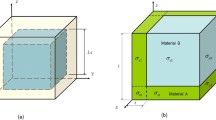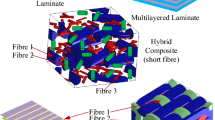Abstract
The Poisson’s ratio describes an extent of transverse deformation of a material when an axial strain is applied. A change of the Poisson’s ratio from positive to negative can equip a material with a set of specific properties. In this paper, a study of a composite material with a tunable Poisson’s ratio is presented. Samples of such a composite were first fabricated with two different polymers based on a composite structure proposed in our previous work using a multi-material additive-manufacturing system. Using both experimental and numerical methods, deformation mechanisms and mechanical properties of this composite material were analyzed. The obtained results demonstrate that its Poisson’s ratio can be reduced by increasing the difference in stiffness of constituent materials and turned from positive to negative when this difference is sufficiently high. Additionally, the study also validates a possible method to fabricate composites with designed structures and multi-constituent materials using additive-manufacturing techniques.








Similar content being viewed by others
References
Liu Y, Hu H (2010) Sci Res Essays 5:1052
Prawoto Y (2012) Comp Mater Sci 58:140
Lakes RS, Witt R (2002) Int J Mech Eng Educ 30:50
Lakes R (1987) Science 238:551
Evans KE, Alderson KL (2000) Eng Sci Educ J 9:148
Evans KE, Alderson A (2000) Adv Mater 12:617
Grima JN, Daphne A (2010) Phys Status Solidi (b) 248:111
Soman PP, Fozdar DY, Lee JW et al (2012) Soft Matter 8:4946
Olympio KR, Gandhi F (2009) J Intell Mater Syst Struct 21:1737
Wang ZY, Hu H (2013) Text Res J. doi:10.1177/0040517512449051
Liu Y, Hu H, Lam JKC et al (2010) Text Res J 80:856
Ge Z, Hu H (2013) Text Res J 83:543
Hu H, Wang Z, Liu S (2011) Text Res J 81:1493
Ma Z, Bian H, Sun C et al (2010) Proceedings of the 2009 ground vehicle systems engineering and technology symposium (GVSETS) 1
Scarpa F, Yates JR, Ciffo LG et al (2002) J Mech Eng Sci 216:1153
Friis EA, Lakes RS, Park JB (1988) J Mater Sci 23:4406. doi:10.1007/BF00551939
Alderson A, Alderson KL (2007) J Aerosp Eng 221:565
Yang W, Li Z, Shi W et al (2004) J Mater Sci 39:3269. doi:10.1023/B:JMSC.0000026928.93231.e0
Kaminakis NT, Stavroulakis GE (2012) Compos B 43:2655
Scarpa F, Blain S, Lew T et al (2007) Compos A 38:280
Yang DU, Lee S, Huang FY (2003) Finite Elem Anal Des 39:187
Mitschke H, Schwerdtfeger J, Schury F et al (2011) Adv Mater 23:2669
Fozdar DY, Soman PP, Lee JW et al (2011) Adv Funct Mater 21:2712
Xu B, Arias F, Brittain ST et al (1999) Adv Mater 11:1186
Lakes R (1987) Science 235:1038
Alderson A, Evans KE (2002) Phys Rev Lett 89:1
Miller W, Ren Z, Evans KE (2012) Compos Sci Technol 72:761
Miller W, Hook PB, Smith CW et al (2009) Compos Sci Technol 69:651
Bertoldi K, Reis PM, Willshaw S et al (2010) Adv Mater 22:361
Hou X, Hu H, Silberschmidt V (2012) Compos Sci Technol 72:1848
Acknowledgements
The author would like to thank the funding support from the Research Grants Council of Hong Kong Special Administrative Region Government in the form of a GRF project (grant no. 515812).
Author information
Authors and Affiliations
Corresponding author
Rights and permissions
About this article
Cite this article
Hu, H., Silberschmidt, V. A composite material with Poisson’s ratio tunable from positive to negative values: an experimental and numerical study. J Mater Sci 48, 8493–8500 (2013). https://doi.org/10.1007/s10853-013-7666-1
Received:
Accepted:
Published:
Issue Date:
DOI: https://doi.org/10.1007/s10853-013-7666-1




